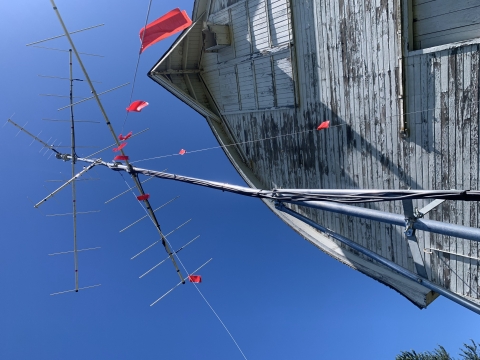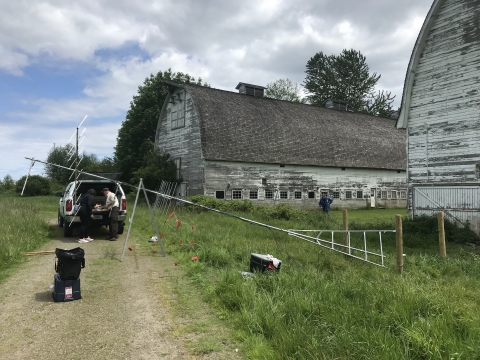Every year, thousands of birds migrate through our refuge. We know more today than we knew even ten years ago about where and how they migrate. But what we know is still not even close to the full picture. In 2022, we set up an automated radio-telemetry tower to help us fill in some of the gaps. The structure structure
Something temporarily or permanently constructed, built, or placed; and constructed of natural or manufactured parts including, but not limited to, a building, shed, cabin, porch, bridge, walkway, stair steps, sign, landing, platform, dock, rack, fence, telecommunication device, antennae, fish cleaning table, satellite dish/mount, or well head.
Learn more about structure will provide new opportunities to collect data on tagged flying animals that have visited the refuge.
The structure in question is a part of the Motus Wildlife Tracking System, a network of automated radio-telemetry stations that allows for data sharing among researchers. Motus is Latin for movement, which is fitting as the data collected by these receivers details the movement of flying animals. But there are other necessary components of this system. The most important is the nano tag transmitters scientists place onto birds, bats, and even large insects! These tags emit a unique radio signal picked up by radio telemetry receivers at sites like ours. The tower constantly acts as a receiver for these radio signals, if the nano tag transmitter battery is still running.
Refuge Biologist, Ryan Munes, said the main reason we installed the tower at the refuge is to support migratory bird research. While we don’t have any bird tagging and monitoring projects of our own going on at the refuge, we can do our part and add data as a migratory stopover site.
The Motus system is an international collaboration of government agencies, universities, and private citizens. In the U.S., it is extensively used in the Midwest and along the East Coast. Our tower is part of an ongoing effort to expand the network on the West Coast, as most monitoring sites right now are in California and British Columbia. When the receiving tower was installed, it was positioned to pick up migratory bird activity in the estuary and the freshwater wetlands. There are plans for other refuges in our region to install towers, too, at sites that are important stopovers for shorebirds during migration.
Now at this point you may be asking: “when do we know if a bird is in the area?” Or “how can I stay up to date on the tower?” That is one of the most exciting things about the receiver! The data is public. The Motus website (https://motus.org/) can seem tricky at first, but the map provided gives an overview of the different sites where the receiving towers are located; and it shows the recent tag signals that have been picked up.
Visit https://motus.org/data/receiversMap to explore Motus sites on an interactive map. Our tower is the Nisqually Delta Motus ID# 8691. Be sure to check the site at Grays Harbor also, near Grays Harbor National Wildlife Refuge: Breckenridge Bluff ID# 8580.





